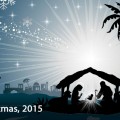Christmas 2013
It?s home for the holidays for me?again for the third time in four years. But where is home? Where I was born and raised? Or where I spent two-thirds of my life? Or is home anywhere I happen to be assigned as a Jesuit?
Last year home was Guam, where I found many interesting challenges?a culture that looked deceptively like middle-class USA?with suburban-style homes, more than one car parked in the driveway, and plenty of 9-5 jobs available. But all that masks a culture that is just as distinctive as Chuukese or Pohnpeian or any other Micronesian culture.
Besides surviving the early (5:45 AM) masses I would say a couple of times a week, I was proudest of being able to help with a public education program on the first Jesuit missionary?first not just in Micronesia but in the entire Pacific?Fr. Diego Luis de San Vitores. This 17th century missionary, now a candidate for canonization, has been badly mistreated by early historians. He was blamed for the enormous reduction of population of the islands by unleashing musketballs on the people during the course of the so-called ?Spanish-Chamorro Wars.? Our job was to rehabilitate the image of the man and his mission, but to do so in a historically honest way, using the Spanish sources for the period that now abound. In doing that, we hoped that we would free the people of Guam and the Northern Marianas from the unhappy choice many seemed to face: either be true to their church and overlook the ?genocide and cultural loss? that San Vitores and the Spanish presumably unleashed, or vote on behalf of their ethnicity and deny the Jesuit a place among the saints, consigning him instead to the haunt of demons.
My last few months in the islands were full and satisfying. There was a talk at a big event on Yap to celebrate historical ties between Yap and Palau… a two-day retreat for teachers at Assumption School on Majuro… a week-long meeting of the education reform team in Chuuk in late July… a talk at Xavier HS graduation, and a two-day session on island culture during orientation week before the opening of the new school year.
But that was then. Now I?m in New York living on the Fordham campus trying to stitch together a work routine that can satisfy my workaholic demands. So far it?s not even close. I?m helping out with liturgies at our retirement community, doing odds and ends at Campus Ministry, and giving a talk or two at one of the graduate programs. But little projects help fill in the time?the monograph on German rule in the islands a century ago, the education project on Micronesia I hope to continue, and maybe even another video on island migrants to the US. Another godsend has been the family gatherings?like the big family wedding in late October, or the get-together in the Adirondacks promised at the end of Christmas week.
What we?re all left with as we await Christmas is the promise of a promise. These remaining days before Christmas we look forward to celebrating the birth of a special child. But the birth itself wasn?t the end of the story, just a promise of a time when Syrians and Jews, like the lions and lambs in Isaiah, will happily coexist. We all know it hasn?t happened yet, but we look forward to the time when the promise will be fulfilled. Perhaps the peace we find this Christmas will be the assurance that we might not have reached the top of that mountain quite yet… but sooner or later we will.

Fran Hezel, SJ
Spellman Hall, Fordham University, Bronx, NY 10458






